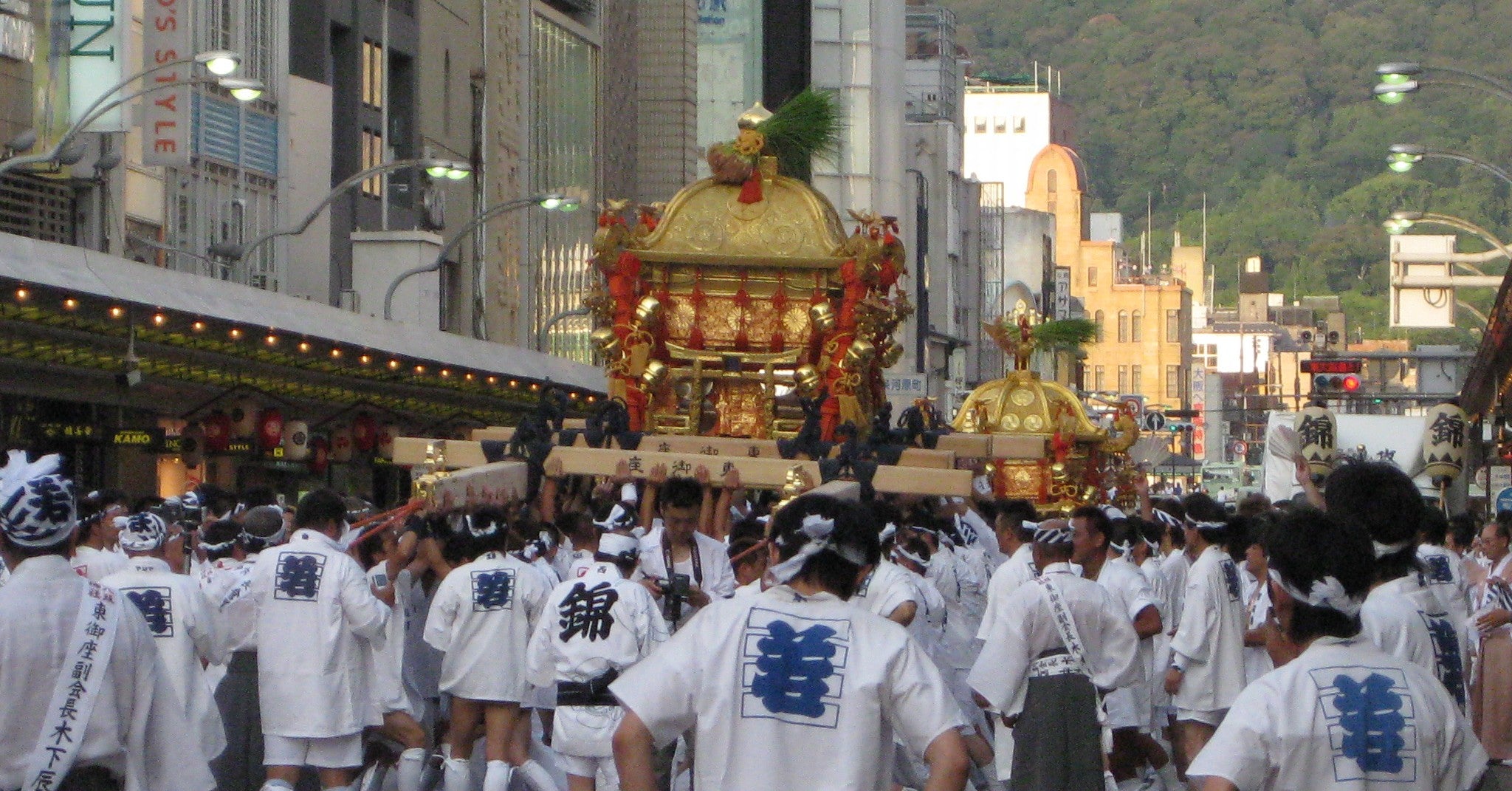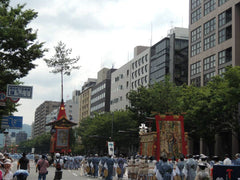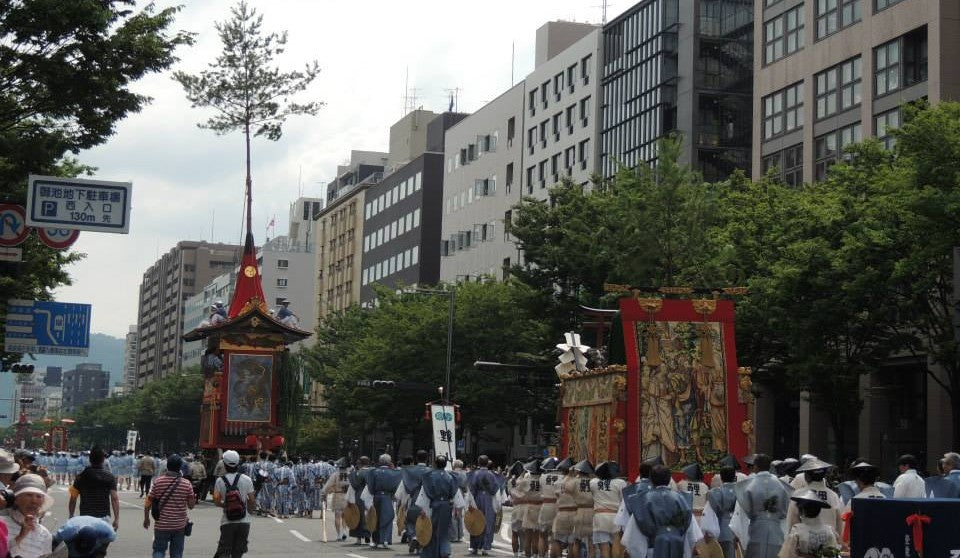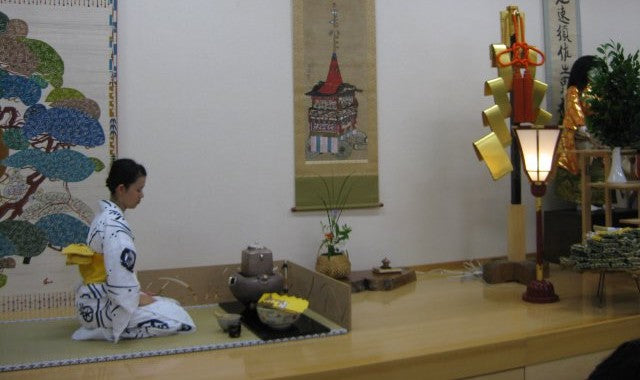
Gion Matsuri main events calendar
-
July 7: Shrine visit by the Chigo of Ayagasaboko
The Chigo (sacred children) of Ayagasaboko visit Yasaka Shrine to pray for the success of Gion Matsuri.

-
From July 10: Building of the Yamaboko floats for the Saki Matsuri parade
One of the highlights of the Gion Matsuri is the building of the Yamaboko floats.
The yamaboko floats are assembled with only ropes without using nails or whatsoever. The ropes are tightening using a traditional method called “Nawa garami.” The ropes can only be seen on July 7, because they are hidden by decorating aprons and slip-guards for the remainder of the festival.
Yamaboko building order
July 10: Naginataboko, Kankoboko, Niwatoriboko, Kikusuiboko, Tsukiboko
July 11: Houkaboko, Funaboko, Iwatoyama
July 12: Houshouyama, Yamabushiyama, Ashikariyama, Hakugayama
July 13: Uradeyama, Araretenjinyama, Kakkyoyama, Ashikariyama, Aburatenjinyama, Tokusayama, Taishiyama, Hakurakutenyama, Ayagasahoko, Tourouyama
July 14: Shijoukasaboko, Mousouyama -


-
July 10: Omukae chōchin or Welcoming Lanterns ceremony
Some volunteers from the Buddhist lantern festival (Mandoue) hang large Japanese lanterns (chōchin) and form a parade to welcome the Mikoshi (portable shrine) and purify the streets before the Mikoshi Purification Ceremony is performed.
A procession of little boys dressed up as samurais, Gion Geiko and Maiko performing the Komachi-odori (Young Ladies' Dance), and children dressed up as white herons performing the Shirasagi no mai (white heron dance) parades in the Gion district.

-
July 10: Mikoshi Arai (Mikoshi Purification Ceremony)
On July 10, the three deities of Yasaka Shrine, Susanoo no Mikoto, Kushiinadahime no Mikoto, and Yahashira no Mikoto, leaves the shrine carried via Mikoshi to be purified. While the mikoshi carrying Susanoo no Mikoto is carried down to Shijo Bridge, the mikoshi carrying Kushiinadahime no Mikoto, and Yahashira no Mikoto are headed to Yasaka Shrine kagura hall, where the purification ceremonies take place.
Torches are lit in the precincts of Yasaka Shrine. The mikoshi bearers carry them on their shoulders and proceed down Shijo Street. While watching over the torches and lanterns, water from the Kamo River drawn from the Shijo Ohashi Bridge is mixed with sakaki (species of evergreen sacred to Shinto) and sprinkled on the portable shrine.
-


-
July 12 and 13: Saki Matsuri – Yamaboko hikihajime
When the building of the Yamaboko is over, each float undergoes a trial run when people will practice pulling them, as Gion Bayashi (Gion Festival Music) fills the air. Members of the public can participate in the trial run.
Naginataboko: July 12, 15:30
Kankoboko: July 12, 14:00
Tsukiboko: July 12, 15:00
Niwatoriboko: July 12, 14:30
Kikusuiboko: July 12, 15:00
Houkaboko: July 13, 15:00
Iwatoyama: July 13, 15:00
Funaboko: July 13, 15:00
Tourouyama: July 13, 12:00 
-
July 13: The Sacred Children Shrine visit
Naginataboko Chigo
Riding on a white horse, the Chigo (sacred child) of Naginataboko visits Yasaka shrine to pray for the success of Gion Matsuri.
Kuze chigo
Kuze Chigo (sacred children) are children chosen from the parishioners of Ayatokunaka-jinja Shrine who visit Yasaka Shrine to pray for the success of Gion Matsuri. Kuze chigo are also known as Komagata chigo, because they carry around their necks the object of worship of Ayatokunaka-jinja, a horse head carved out of wood (komagata).

-
July 14 to 16: Yoiyama and Byōbu Matsuri
During Yoiyama period, the sacred object of the floats and other decorations are displayed. Gion Bayashi (Gion Festival Music) also fills the streets of Kyoto.
The highlight of Yoiyama is that you can see the magnificent and carefully preserved ornaments of the Yamaboko from up close.
At the same time, old family houses and long-established shops in the Yamaboko-cho area graciously open their doors to show the “Byobu-kazari” (folding screens) that they possess to the public. So, the event is also known as “Byōbu Matsuri” or the Folding Screen Festival.
-



-
July 16: Hoen Senshoji Sakaki Tate (Gion Festival sacred Sakaki tree Parade)
Location: Higashinotōin Bukkōji higashi-iru
There used to be three sakaki altars which led each of the mikoshi throughout Kyoto’s street, but only one, Houensenshoji Sakaki is still in existence.
During the yoiyama evenings leading up to the yamaboko parade, a sakaki tree is set up as a yorishiro to welcome the kami and is then decorated and enshrined. The altar leads the central mikoshi during the Shinko Festival or the festival celebrating the temporary transfer of a shintai away from its main shrine.
Each float has its own chimaki (charms made out of bamboo leaves for protecting against disease and disaster). However, the only chimaki to receive a purification ritual at Yasaka Shrine are those of Houensenshoji Sakaki.

-
July 16: Iwami Kagura
Iwami Kagura is a traditional ritualistic dance from Iwani (former province located in the west of present-day Shimane Prefecture). The dance is performed as a form of prayer to gods.
During Iwami Kagura, an odyssey of Susano no Mikoto, the enshrined deity of Yasaka Shrine, is performed.

-
July 16: Hiyori Kagura
The musicians of each float participating in the Saki Matsuri parade back and forth between the place where the mikoshi take rest and each town hall, while playing the sound of Hiyori Kagura to pray for fine weather.
Naginataboko is the only float to proceed to Yasaka Shrine for dedication.
Naginataboko: July 16, 22:00
Kankoboko: July 16, 22:00
Tsukiboko: July 16, 21:30
Niwatoriboko: July 16, 21:40
Kikusuiboko: July 16, 22:00
Houkaboko: July 16, 21:30
Iwatoyama: July 16, 22:00
Funaboko: July 16, 22:00
Ayagasaboko: July 16, 21:00
Shijoukasaboko: July 16, 21:40 
-
July 17: Saki Matsuri – First Float Procession (Yamaboko Junkō)
The procession purifies the streets of Kyoto to welcome the gods to town. It is said that the Yamaboko collect misfortune as they make their way through Kyoto. So, the Yamaboko are immediately disassembled at the end of the parade to ensure that the ill spirits that have been gathered are not released.
When the Naginataboko, which leads the parade, reaches Shijo-dori Fuyacho in the center of Kyoto, the float’s chigo (sacred child) must cut the shimenawa (a sacred cord) for the festival to begin. The “Kuji Aratame” ceremony is held in Shijo-dori Sakaimachi in order to ensure the correct order of yamahoko floats in the parade.
The highlights of the parade are the scenes called “tsuji-mawashi” (when the floats change their direction by 90 degrees), the Gion main street filled with the festival, and the procession’s final thoroughfare in Shinmachi-dori Street.
Tourouyama is the only float in the Gion Festival with a mantis on the roof raising its forelegs and flapping its wings as it parades through Kyoto busy streets, which make this float very popular among the public.
-



-
July 17: Shinkousai
Following the prescribed route, the three mikoshi, each carrying a diety of Yasaka Shrine, are transported from Yasaka Shrine to the Otabisho (the place where the sacred palanquins are lodged during the festival) in Shijo Teramachi. The three deities of Yasaka shrine will be enshrined there until July 24.

-
July 17: Ato Matsuri – Building of the Yamaboko floats
In the same way as for the Saki Matsuri, the building of the Yamaboko for the Ato Matsuri starts.
Yamaboko building order
July 18: Ofuneboko
July 19: Kitakannonyama, Minamikannonyama, Koiyama
July 20: Jomyoyama, Kurunushiyama, Ennogyojayama, Suzukayama, Hachimanyama
July 21: Hashibenkeiyama -


-
July 20 to 21: Ato Matsuri – Yamaboko hikihajime
In the same way as for the Saki Matsuri, when the building of the Yamaboko is over, each float undergoes a trial run in their neighborhoods when people will practice pulling them, as Gion Bayashi (Gion Festival Music) fills the air. Members of the public can participate in the trial run.
Ofuneboko: July 20, 15:00
Kitakannonyama: July 20, 15:00
Minamikannonyama: July 20, 15:00
Hashibenkeiyama: July 21, 11:00 -


-
July 23: Ennogyojayama – Goma Taki offering (fire rituals)
En no Gyoja, the shintai of the float Ennogyojayama, is considered to be the founder of Shugendo (Japanese mountain asceticism incorporating Shinto and Buddhist concepts). Since the festival is closely associated with Shugendo, a Yamabushi (practitioner of Shugendō) from Shogoin Temple prays for the success of Gion Matsuri by burning wooden prayer sticks (gomagi) in a consecrated flame in front of the Ennogyojayama.
Buddhist monks go along Sanjō Street to the west blowing a conch as they head towards Ennogyojayama.
After the "Yamabushi Mondo" scene, Buddhist monks purify the air by pointing arrows in the four cardinal directions and splitting the air with a sword. When the purification ceremony is over, the gomadan (altar used in the goma taki rituals) is set on fire by the Yamabushi and prayers are said.
-


-
July 23: Minamikannonyama – Abare Kannon (rampaging kannon)
Minamikannonyama is one of the parading floats during the Ato Matsuri. “Abare Kannon” is a unique event of Minamikannonyama held late at night. In this event, one of the shintais of the float is covered with cloth and hanged to a pedestal as the float parades in the neighborhood. The event is called “Abare Kannon” because the shintai is shaken up and down wildly during the process.

-
July 23: Hiyori Kagura
The musicians of each float participating in the Ato Matsuri parade back and forth around the place where the mikoshi take rest and each town hall to the sound of Hiyori Kagura to pray for fine weather.
Ofuneboko: July 23, 21:30
Kitakannonyama: July 23, 21:30
Minamikannonyama: July 23, 20:30 
-
July 24: Ato Matsuri – Second Float Procession (Yamaboko Junkō)
On July 24, the ten floats participating in the Ato Matsuri leave their neighborhoods led by the Hashibenkei float to gather at Oike-dori Karasuma, Nakagyo Ward, Kyoto. The float precession is to set off at 09:30 am.
The Ato Matsuri float procession proceeds on the opposite course of the Saki Matsuri procession on July 17.

-
July 24: Hanagasa Junkō (Flower Umbrella Procession)
Originally the Gion Matsuri two grand parades were held on July 17th (Saki Matsuri) and on July 24th (Ato Matsuri). But when the parades were united in 1966, the Hanagasa Junko (Flower Umbrella Procession) was created to replace the second grand parade (Ato Matsuri) held on July 24th. In 2014, the Ato Matsuri was officially revived, but it was decided to keep the Hanagasa Junko and held it together with the Ato Matsuri procession.
In the event, ten colorful umbrella floats accompanied by Uma-osa Chigo (costumed sacred child riding a horse) and chigo dressed up as samurais parade in a procession along a designated course. When the procession arrives at Yasaka Shrine, various dances are performed as offerings to the gods.
-


-
July 24: Kankousai
The portable shrines are carried along a set route from Otabisho in the downtown of Kyoto to Yasaka Shrine.
Around 11:00 pm, the three portable shrines are placed on the stage at the center of Yasaka Shrine so that the ceremony can start. The south tower gate of Yasaka Shrine is then closed. Finally, the area surrounding the shrine is enveloped in darkness as the lights are turned off. The mitama utsushi (a Shinto ritual for transferring spirit) is performed in this unique atmosphere.
When the spirits travel from the Kagura Hall in Yasaka Shrine to the main shrine to the sound of a Japanese harp, the interjection "Oh, oh" echoes through the Shrine.
This ritual performed quietly at night is solemn, wondrous and worth seeing.

-
July 31: Closing service at Eki Shrine (summer purification ritual)
Closing out the month-long festivities is a summer purification ritual, at the Eki auxiliary shrine, in Yasaka Shrine.
Visitors must pass through a cogon grass ring attached to the torii (gate) to protect themselves against misfortune.




Leave a comment
This site is protected by hCaptcha and the hCaptcha Privacy Policy and Terms of Service apply.